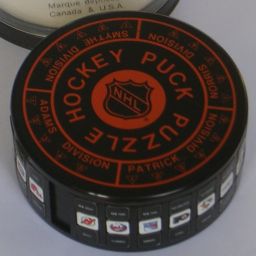


The NHL Hockey Puck Puzzle is a cylindrical sliding puzzle. It is split into three layers, and around its sides are 24 columns with room for three sliding tiles. The layers can rotate, shifting all the tiles it contains to different columns, and the tiles can slide vertically within a column if there are fewer than 3 tiles in it. When it is solved, most columns contain the logo of an NHL team on the middle tile, and the name of that team split in two parts on the top and bottom tiles. Two of the columns will contain blank tiles, and one column will be completely empty. The columns should be in the order shown in the accompanying leaflet and as indicated by the numbering on the top of the puzzle.
This puzzle is very similar to Whip-It, Varikon, and the Babylon Tower, except that it has three empty slots instead of just one. This makes it rather easy to solve once the intended solution arrangement is known. For an extra challenge, you can try to solve it without rotating the outer layers, using just the middle one.
Here are the teams and logos in the correct order.
| Norris Division | ||||
|---|---|---|---|---|
| 1. | 2. | 3. | 4. | 5. |
| Chicago | Detroit | Minnesota | St. Louis | Toronto |
| Black Hawks | Red Wings | North Stars | Blues | Maple Leafs |
| Smythe Division | ||||
|---|---|---|---|---|
| 1. | 2. | 3. | 4. | 5. |
| Calgary | Edmonton | Los Angeles | Vancouver | Winnipeg |
| Flames | Oilers | Kings | Canucks | Jets |
| Adams Division | ||||
|---|---|---|---|---|
| 1. | 2. | 3. | 4. | 5. |
| Boston | Buffalo | Hartford | Montreal | Quebec |
| Bruins | Sabres | Whalers | Canadiens | Nordiques |
| Patrick Division | |||||
|---|---|---|---|---|---|
| 1. | 2. | 3. | 4. | 5. | 6. |
| New Jersey | New York | New York | Philadelphia | Pittsburgh | Washington |
| Devils | Islanders | Rangers | Flyers | Penguins | Capitals |
The NHL Hockey Puck Puzzle was invented by Ali Rahmani, who filed a patent for it on 29 November 1983, CA 1,199,351, which was published 14 January 1986.
There are 72 tile locations (24 columns on 3 discs), but there are 6 identical blank tiles, 2 identical New York tiles, and 3 empty slots. This gives a total of 72!/(6!2!3!) = 7,087,321,571,398,852,646,009,730,368,666,050,085,738,205,067,673,301,965,720256,361,571,572,336,483,991,814,144,000,000,000,000,000 or approximately 7.1·1099 positions. The puzzle is much easier than this number suggests because there are so many empty slots.
Note that if you are solving a piece that belongs in the middle disc (i.e. a logo piece) then you can combine steps e and f, swapping out one piece for the other.